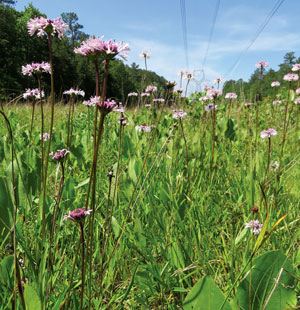A Wild Prairie for the Blomquist Gardens

Duke Gardens officials have started clearing an area in the Blomquist gardens in preparation for seeding a new prairie ecosystem. Photo by Les Todd/Duke Photography
A wild prairie is coming to Sarah P. Duke Gardens, but don't expect it to look like the American Midwest.
Robert Mottern, director of horticulture, said the new Piedmont Prairie planned for the H.L. Blomquist Garden of Native Plants will give visitors an insight on what a more local endangered ecosystem looks like.
An area has been cleared out in the Blomquist Garden for planting the prairie this summer. “The quarter-acre space had been heavily wooded and didn’t allow for the growth or display of plant species requiring full sun,” said Mottern. “A prairie is one of those habitats that must have a full sun exposure.”
According to Mottern, Stefan Bloodworth, curator of the Blomquist Garden, wanted to display an ecotype that has not been previously represented in Duke Gardens. From growing up in the area, Bloodworth was familiar with these threatened environments.
The plants that will be featured in the prairie include wild herbaceous flowering plants such as roundleaf thoroughwort (Eupatorium rotundifolium), starry rosinweed (Silphium asteriscus) and New York ironweed (Vernonia noveboracensis). It also includes grasses such as beaked panicgrass (Panicum anceps), splitbeard bluestem (Andropogon tenarius) and indiangrass (Sorghastrum nutans).

Many plants that will be featured in the prairie came from seeds that Blomquist horticulturist Annabel Renwick spent 6 months collecting from wild fields along rural roadsides. Renwick delivered the seeds to Hoffman’s Nursery in Bahama, which will germinate them and return them in the form of 8,000 potted plugs representing 11 species of native grasses. Renwick is growing many of the wildflowers in the gardens’ nursery. To learn more about this process, read Renwick’s “Riches in the Ditches” article online in Duke Gardens’ 2015 Flora magazine.
Prior to European settlement, the prairies numbered in the thousands of acres throughout the Carolinas, Mottern said. Now there are only a handful of remnant Piedmont prairies.
“Prairies are rare, endangered, threatened places. There is very little of this ecotype or ecozone in the state anymore," he said. "A couple of local ones are Temple Flat Rock preserve in Wendell, Horton Grove Nature Preserve near Historic Stagville north of Durham, and Penny’s Bend Nature Preserve on the Eno River.” Other pockets exist in utility easements and right-of-ways.
Mottern said the Piedmont prairies contained more open woodland than the existing prairies of the Midwest. The soils in the Midwest were deep and rich and supported a dense tall grass habitat. Piedmont prairies typically grew on poor droughty soils that favored short grasses and drought tolerant wildflowers. He said because these soils didn’t support a high level of competing trees and shrubs, grasses and small plants were able to thrive. Fire was also an integral component of maintaining the prairies. Every three to five years the prairies would burn set by lightning strikes or by Native Americans. Fire kept the understory clear and only permitted fire tolerant plant species to predominate.
“Most of the prairies that used to exist here weren’t like normal waves and fields of grasslands in places like Nebraska or Kansas," Mottern said. "There would have been trees scattered here and there and open spaces. You wouldn’t have this dense understory like you see now.”
A regular controlled burn will be desired to maintain the ecosystem in a natural state, but annual mowing is also an option, he said.
The project was made possible by a donation from the family of former Duke Gardens Board of Advisors member Marcia Angle in her honor.
Mottern added that the new prairie will be popular for birdwatchers, as prairies serve as "seed factories" for birds.
A covered structure will also be part of the project where small groups of students and visitors can meet to learn about the prairie ecosystem.
“We want to create a valuable educational experience for people and an appreciation for protecting these rare and beautiful prairies that are still in existence in this area,” Mottern said.
Shakira Warren is a rising junior at N.C. Central University and a summer intern at Duke's Office of News and Communication.